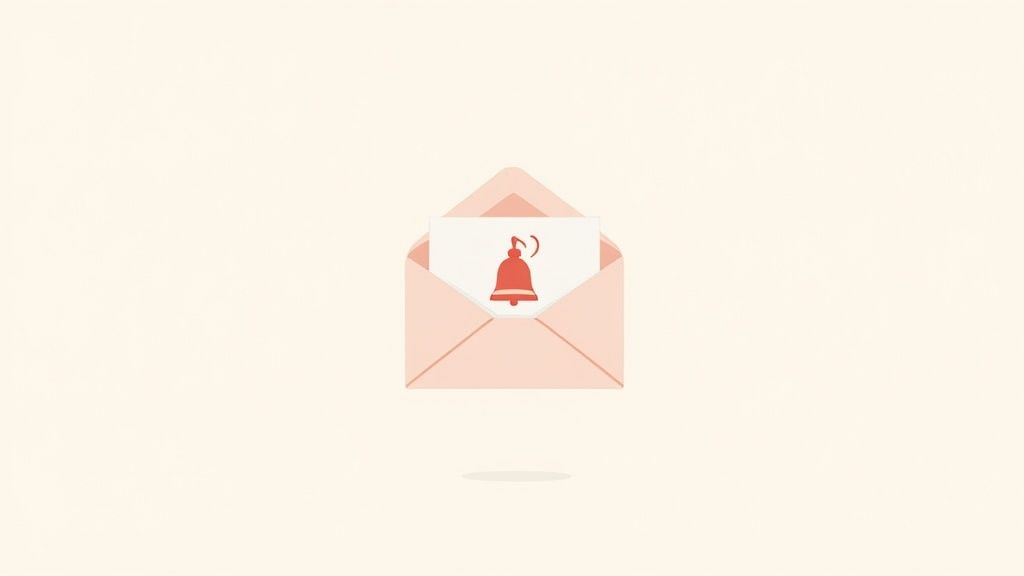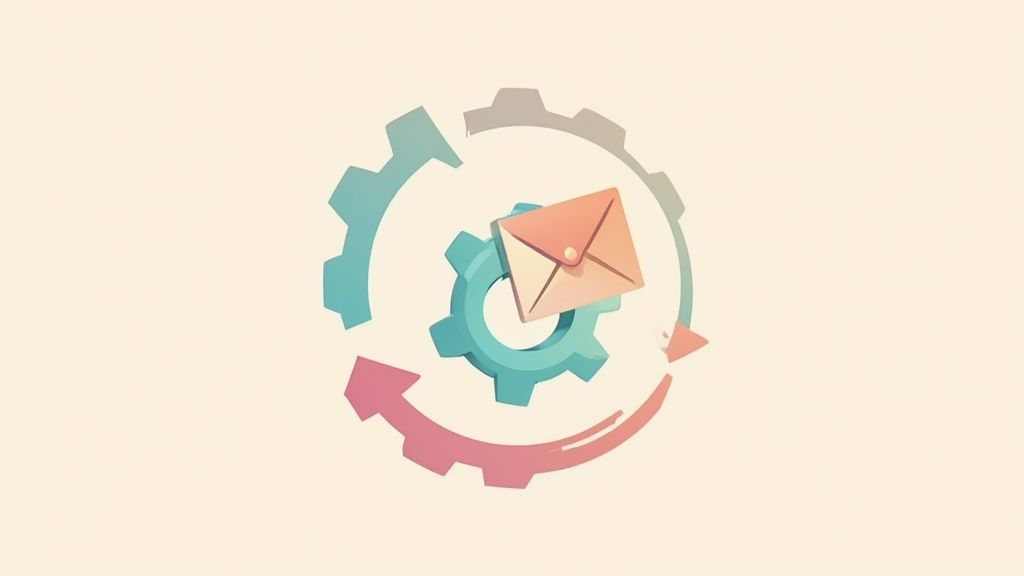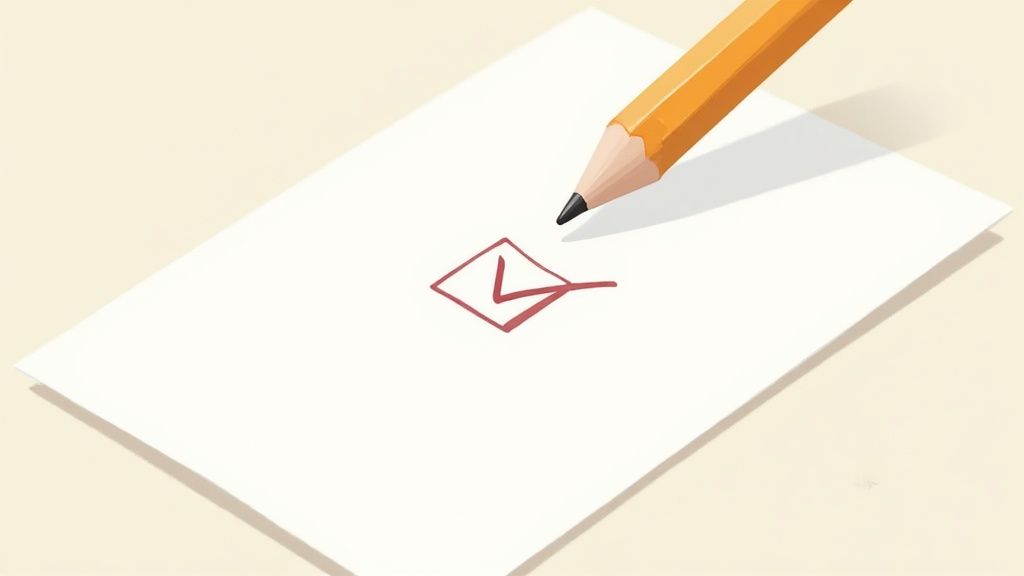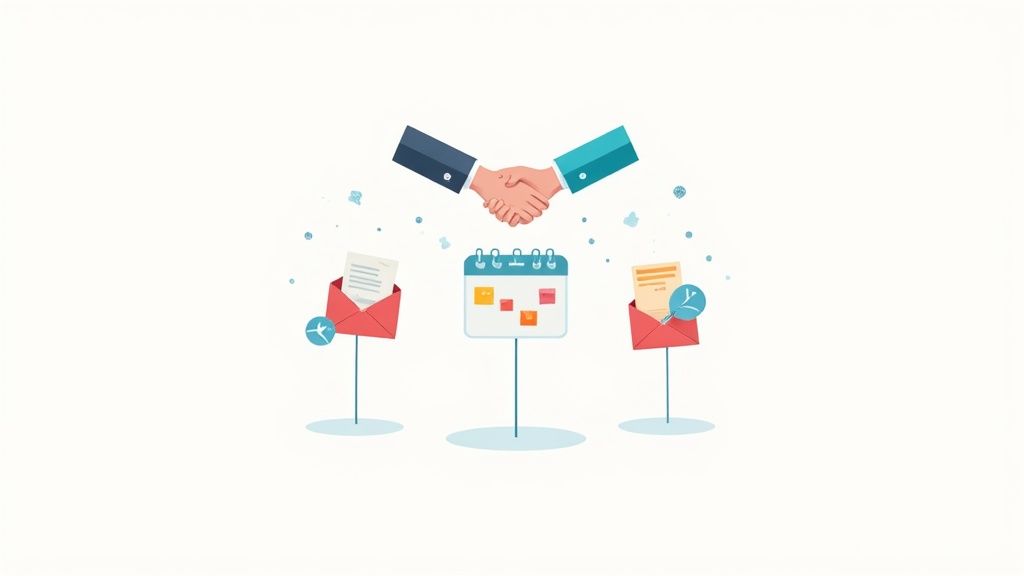Table of Contents
Why Automated Email Reminders Outperform Everything Else
Let’s be real, we all forget things sometimes. Deadlines whoosh past, appointments vanish from our calendars, and online shopping carts sit patiently waiting for us to remember them. That’s where the power of automated email reminders comes in. They’re not about being annoying; they’re about providing helpful nudges at just the right time. Think of them as your super-efficient digital assistant, anticipating your audience’s needs before they even realize they have them.
This proactive approach really connects with people. Have you ever felt relieved after receiving a reminder about an upcoming bill or an expiring free trial? That’s because these reminders add real value by helping us avoid those “oops” moments. They turn a potentially negative experience (a late fee, a missed opportunity) into a smooth and positive one.
Automated email reminders have seriously changed the game for marketing and customer service. We’re talking about a major boost in engagement. Think 70.5% higher open rates and a whopping 152% higher click-through rates compared to regular marketing emails, according to Omnisend’s 2022 data. For a deeper dive into the automated appointment reminder market, check out this report: Automated Appointment Reminder Market Report. These numbers show how effective timely, targeted messaging can be.
The Psychology Behind Effective Reminders
Why such a huge difference in performance? It all comes down to context and relevance. Traditional email blasts often send generic messages to massive lists, hoping something will resonate. Automated reminders, however, are triggered by specific user actions or events. This makes them feel much more personal and immediate.
For example, imagine someone abandons their online cart. A well-timed reminder can bring them back while they’re still thinking about that purchase. The key isn’t just sending more emails; it’s about sending smarter emails that people actually want to open. This targeted approach leads to much higher conversion rates.
Real-World Results: From Abandoned Carts to Boosted Conversions
The impact of automated email reminders is clear across various industries. E-commerce businesses often see a 40% or higher recovery rate for abandoned carts with effective reminder sequences. SaaS companies offering free trials can boost their conversion rates by 3x simply by sending timely reminders about upcoming expirations. These aren’t just random stories; these are results backed by data.
From my own experience, I’ve seen how strategically planned automated reminders can drastically improve key metrics. I worked with a small law firm that boosted their completed client onboarding by 20% just by automating document submission reminders using a platform like Superdocu. Not only did this free up their administrative staff, but it also made the whole client experience much smoother. These real-world examples show the tangible benefits of using automated reminders.
Let’s look at a comparison to really drive the point home:
Automated vs. Traditional Email Performance Comparison
A side-by-side comparison of key metrics between automated email reminders and traditional batch emails
| Metric | Traditional Emails | Automated Reminders | Improvement |
|---|---|---|---|
| Open Rate | 20% | 34.1% | 70.5% |
| Click-Through Rate | 2% | 5.04% | 152% |
| Abandoned Cart Recovery | 10% | 40% – 50% | 300% – 400% |
| Free Trial Conversion Rate | 10% | 30% | 200% |
The table above illustrates the significant improvements observed across key email marketing metrics when using automated reminders compared to traditional email blasts. The data highlights the effectiveness of automated reminders in re-engaging users and driving conversions. By sending targeted messages triggered by specific user actions, businesses can significantly enhance their email marketing performance.
Mapping Your Customer Journey For Perfect Timing
Let’s be honest, nobody likes intrusive emails. The key to effective automated email reminders is making them feel helpful, not annoying. That all comes down to understanding your customer’s journey. Think of it like this: seasoned marketers are always auditing customer touchpoints to find those perfect moments when a reminder truly adds value.
Identifying Key Touchpoints and Friction Points
Imagine the steps a customer takes, from first discovering your brand to becoming a loyal fan. Where do people tend to drop off? In e-commerce, abandoned carts are a classic example. In the SaaS world, it might be trial expirations or struggling to adopt a new feature. These friction points are golden opportunities for a well-timed automated email reminder.

Platforms like Mailchimp use visual interfaces like this to map customer actions and trigger targeted emails. The real takeaway here is the power of visually mapping the user journey, including decision points and corresponding email actions.
Prioritizing Reminders for Maximum Impact
You don’t need to automate everything. Seriously. Focus on the reminders that will move the needle. Ask yourself: Which actions are most valuable? Which reminders are most likely to re-engage customers? From my experience, a document collection platform like Superdocu makes it easy to automate reminders for document submissions. This seemingly small tweak can drastically improve client responsiveness and speed up onboarding. It’s a game-changer for many businesses.
Avoiding the “Automation Overload” Trap
It’s tempting to go crazy with automation, but resist the urge! Bombarding customers with too many reminders is a recipe for disaster. Remember, quality over quantity. Every single reminder needs a clear purpose and must provide value to the recipient. This builds trust and strengthens customer relationships. The alternative? Driving customers away with an overflowing inbox.
Focus on creating automated email reminders that genuinely help your customers. This customer-centric approach is what separates successful automated email campaigns from the flops. By strategically placing reminders within the customer journey, you create a helpful and engaging experience.
Building Workflows That Actually Convert

This is where the rubber meets the road: crafting automated email reminders that don’t just gather dust in inboxes, but actually inspire action. We’re going to dive into setting up workflows that work—from recovering those abandoned shopping carts to minimizing those pesky appointment no-shows. I’ll share real-world examples and show you how to nail the timing, personalize your messages, and sidestep common technical headaches.
Mastering the Timing of Your Automated Email Reminders
Let’s be honest, timing is everything. A reminder that’s too eager feels pushy, but too late, and the moment’s gone. The magic happens when your reminder aligns perfectly with the customer’s needs. This boils down to understanding their journey, something we touched on earlier.
- The First Reminder: Think of this as a gentle nudge, sent shortly after the triggering event. If someone abandons their cart, maybe an hour later. This catches them while they’re still thinking about it.
- The Second Reminder: If nudge number one doesn’t do the trick, try again about a day later. Sweeten the deal this time. Maybe offer a small discount or free shipping to incentivize action.
- The Third Reminder: This is your last shot. A few days later, give them one final, compelling reason to complete their purchase or take action. Don’t be afraid to get a little creative here.
Segmentation: The Secret Sauce for Personalization
Generic reminders? They’re like a shot in the dark. People crave personalized experiences. Segmentation is your secret weapon for tailoring messages to specific customer groups, making them feel seen and understood. Here are a few ideas:
- Past Behavior: What have they bought before? What products have they shown interest in? Use this data to craft hyper-relevant reminders.
- Demographics: Sometimes, targeting based on age, location, or other demographics can significantly boost engagement. Don’t underestimate the power of knowing your audience.
- Engagement Level: How often do they interact with your emails? Tailor your frequency and content accordingly. A less engaged subscriber might need a different approach than a loyal customer.
Integrating Your Automated Email Reminders Smoothly
Your automated email reminders need to play nicely with your existing tools. Platforms like Superdocu make this a breeze, offering integrations with popular CRM and marketing automation platforms. This eliminates data silos and creates a unified customer experience. Want to go deeper on document workflow automation? Check out our guide: Read also: Document Workflow Automation.
Benchmarking for Success
So, how do you know your automated reminders are actually working? Tracking key metrics and comparing them to industry benchmarks is essential. Focus on open rates, click-through rates, and conversion rates. A good target for abandoned cart emails is a 40% recovery rate. For appointment reminders, aim to reduce no-shows by at least 20%.
By mastering these elements, you can create automated reminder sequences that genuinely resonate with your audience and deliver real results. Remember, these reminders are an extension of your brand, so ensure they reflect your values and commitment to customer satisfaction.
Using AI To Supercharge Your Email Automation
I’m going to let you in on a little secret: artificial intelligence is quietly changing the game for email automation. Forget the robots-taking-over narrative; this is about giving your best marketing ideas a serious boost with smart technology. Savvy marketing teams are already using AI tools to optimize everything from catchy subject lines to strategic send times, and it’s paying off big time with better engagement and improved metrics.
AI-Powered Personalization: The Human Touch at Scale
One of the most exciting things about AI in email is the ability to personalize content at scale. Remember the days when tailoring messages for each subscriber was just a fantasy? Now, AI can analyze individual user data and create custom content that feels authentic and human. This kind of personalization used to be a resource hog, requiring massive teams, but now it’s within reach for almost any business.
Let me give you a real-world example: Imagine an online store using AI to analyze browsing history. A customer keeps checking out running shoes? Boom, automated reminders featuring new arrivals or special deals on running gear appear in their inbox. This kind of targeted approach is way more effective because it’s relevant. It feels personal, like a helpful salesperson whispering the perfect recommendation at the right moment.
Predicting Optimal Send Times with Machine Learning
AI isn’t just about personalized messages; it’s about perfect timing, too. Machine learning analyzes past engagement data to predict the best send times for each individual subscriber. Instead of sending mass emails at a fixed time, AI figures out when each person is most likely to open and click. This translates to higher open rates, more click-throughs, and ultimately, better conversions.
This shift to individual send times is a game-changer for email marketing. We’re moving past generic best practices and into a data-driven world, delivering messages when they’ll have the greatest impact.
AI Tools That Deliver Results
The adoption of AI in automated email reminders is significantly shaking up the marketing world. A recent study showed that by 2025, a whopping seven out of ten marketers in the US were already using generative AI tools to optimize email campaigns, with 34% specifically using it to craft compelling email copy. Want to dive deeper into these stats? Check out this resource: Email Marketing Statistics. There are tons of tools out there already making a real difference:
- Subject Line Optimization Tools: AI can analyze mountains of email data to suggest subject lines that grab attention and boost open rates. Tools like Phrasee are great examples.
- Content Generation Platforms: AI can help you draft engaging email copy, giving marketers more time to focus on overall strategy and making those personal touches shine. Consider exploring platforms like Jasper.
- Predictive Analytics Platforms: These tools use machine learning to predict customer behavior and optimize send times for maximum impact. Seventh Sense is a popular choice in this area.
These aren’t just theoretical benefits; real companies are seeing real improvements. From higher conversions to better engagement, AI-powered automation is delivering tangible results across diverse industries. This isn’t about replacing human creativity; it’s about making our best ideas even better.
To give you a sense of some leading tools, here’s a handy table:
Popular AI Tools for Email Automation
| Tool | Primary Use | Adoption Rate | Key Features |
|---|---|---|---|
| Phrasee | Subject Line Optimization | High among enterprise-level businesses | AI-powered subject line generation, A/B testing, performance analysis |
| Jasper | Content Generation | Growing rapidly across various industries | AI-powered email copywriting, personalization features, integrations with marketing platforms |
| Seventh Sense | Predictive Analytics | Significant adoption among email marketers | AI-powered send time optimization, engagement prediction, integration with marketing automation platforms |
This table provides a glimpse into the dynamic landscape of AI email marketing tools. As you can see, there are options for everything from crafting the perfect subject line to predicting the best time to reach your audience. Choosing the right tool depends on your specific needs and goals, but the key takeaway is that AI is here to stay and is transforming how we approach email marketing.
Writing Automated Messages People Want To Read

Let’s be honest, most automated email reminders are…well, a bit robotic. They often end up unread and deleted. But there’s a huge difference between a reminder that gets ignored and one that actually gets someone to take action. The key? Making it feel like a real person wrote it. Think about your own inbox – which emails do you open? The generic, impersonal ones? Or the ones that feel like they’re speaking directly to you?
Crafting Compelling Subject Lines
The subject line is everything. It’s the first (and sometimes only) impression you make. A dull subject line equals a quick trip to the trash. You want something short, catchy, and ideally, personalized. Instead of a bland “Document Reminder,” try something like “Your Documents Are Waiting – Quick Review Needed!” It’s a small change, but it makes a world of difference.
Here are a few tips that have worked wonders for me:
- Personalize it: Use the recipient’s name. It instantly makes the message feel less automated.
- Create Urgency (when appropriate): A subject line like “Don’t Miss Out – Your Trial Expires Soon!” can be highly effective, but use it sparingly.
- Highlight the Value: Focus on what’s in it for the recipient. Something like “Get Started Faster – Complete Your Onboarding Documents” tells them exactly why they should click.
Writing a Message Body That Connects
Okay, so you’ve snagged their attention with a great subject line. Now you need to keep that momentum going. The body of your email should be clear, concise, and helpful. Skip the jargon and get straight to the point – everyone’s busy, so respect their time.
Here’s my recipe for a winning email body:
- Be Friendly: Start with a simple “Hi [Name]”. It’s a small touch, but it adds a personal touch.
- State the Purpose: Tell them why you’re emailing them right away. Don’t make them hunt for the reason.
- Clear Instructions: Make it super easy for them to take the next step. Provide clear instructions or links.
- Friendly Closing: End with a warm closing like “Thanks!” or “Have a great day!” It’s just polite!
For some great examples of effective onboarding sequences, check out our guide: Check out our guide on: Client Onboarding Automation. It’s packed with practical advice for creating automated messages that nurture new clients and set them up for success.
Optimizing for Mobile Readers
These days, most people check their email on their phones. So, your automated email reminders need to be optimized for mobile. Think short paragraphs, bullet points, and clean formatting. Nobody wants to scroll through a wall of text on a tiny screen.
Maintaining Your Brand Voice
Even though these are automated messages, they still represent your brand. Make sure your voice is consistent. Whether it’s friendly and helpful, or professional and direct, let your brand personality shine through.
By following these simple tips, you can transform your automated email reminders from boring notifications into engaging messages that people will actually open and read. The result? Higher open rates, more clicks, and a bigger impact on your bottom line.
Tracking What Matters And Optimizing For Growth
So, you’ve got your automated email reminders up and running—fantastic! But how do you know they’re actually moving the needle? Forget about just looking at open rates (although those are still helpful!). Let’s dive into the Key Performance Indicators (KPIs) that truly show growth and how you can use your data to continuously refine your email strategy.
Beyond Vanity Metrics: KPIs That Correlate With Revenue
Open rates give you a peek into how appealing your subject lines are, but that’s only part of the picture. As marketers, we need to focus on metrics that have a direct impact on revenue. Think conversion rates. Are people actually completing the action you want them to after getting that reminder? Think abandoned cart recoveries, appointments kept, demos scheduled—those are the numbers that tell the real story.
Another crucial metric is Customer Lifetime Value (CLTV). Are your automated emails helping build long-term loyalty? Even a small increase in repeat purchases can significantly boost your bottom line.
Attribution: Proving the ROI of Your Automation
How can you be sure your automated emails are the real drivers behind those conversions? Attribution is key. Use UTM parameters in your email links to track where your traffic and conversions are coming from in Google Analytics. This connects the dots between your reminders and revenue growth, showing the value of your automation investment.

This Google Analytics screenshot perfectly illustrates the importance of campaign tracking. By looking at the source/medium data, you can see exactly which automated email campaigns are bringing the most valuable traffic to your site. This helps you optimize your efforts and concentrate on what’s working.
Spotting Optimization Opportunities and Troubleshooting
Data analysis isn’t just about celebrating successes; it’s also about uncovering areas for improvement. Are some segments not responding to your reminders? Are open rates dipping for a particular type of email? Dig into the data to catch these issues early. Maybe your subject lines need a revamp, or your timing is off. Regularly reviewing your data helps you adjust your strategy and stop small problems from snowballing. For more on workflow optimization, check out our article on document management workflow.
For example, let’s say your cart abandonment reminders aren’t performing well. Analyze the data. Are people clicking the link but not finishing the purchase? Maybe your checkout process needs to be smoother. Are they not even opening the email? Perhaps your subject line isn’t grabbing their attention. Look at the entire customer journey to find and fix those roadblocks.
Ongoing Testing and Continuous Improvement
Email marketing is always evolving. What works today might not work tomorrow. Embrace a culture of A/B testing. Experiment with different subject lines, email copy, calls to action, and send times. Track your results and focus on what connects with your audience. This constant optimization is crucial for long-term success in automated email marketing. Think of your email automation strategy as a living document—always adapting and improving—to maximize its impact on your business growth.
Your Roadmap To Email Automation Success
Alright, let’s talk email automation. Setting up automated reminders can feel daunting, but it doesn’t have to be. I’ve been through this myself, and I’m happy to share what I’ve learned. Think of this as a practical guide, not a rigid set of rules.
Phase 1: Laying the Foundation
First things first, what are you hoping to achieve? Do you want more conversions, smoother onboarding, or something else entirely? Write down your objectives. It helps to keep you focused. Then, think about your customer journey. Where are people dropping off? Those are your key touchpoints for reminders. Lastly, pick the right tools. I’ve used Superdocu for document collection, and it makes automation a breeze.
This initial groundwork is crucial. It’s like planning a road trip: you wouldn’t just hop in the car and start driving, would you?
Phase 2: Building Your Workflows
My advice? Start small. Don’t try to automate everything at once. Pick one key area, like abandoned cart reminders, for your pilot project. Create a simple workflow: a clear trigger (like an abandoned cart), a timing delay (maybe an hour or two), and a personalized message. Test it thoroughly! You don’t want to send out buggy reminders to everyone.
This measured approach lets you iron out any kinks before going big.
Phase 3: Refining and Expanding
Once your pilot is humming along, look at the results. Are you hitting your goals? If not, adjust your timing, messaging, or targeting. Maybe a different subject line or a more compelling offer will do the trick. Then, gradually expand to other areas. After abandoned carts, you might add reminders for appointment confirmations or feedback requests.
Think of it as building a house: you start with the foundation, then add one room at a time.
Long-Term Strategy: Scaling and Integrating (Ongoing)
As your automation matures, consider scaling. How can you automate more without losing that personal touch? AI-powered tools can help with things like subject line optimization and content generation. Also, think about integrating your email reminders with your overall marketing strategy. This creates a cohesive customer experience.
It’s about constantly learning and improving. The digital world is always changing, so your strategies should too.
Ready to give it a shot? Superdocu makes it easy to build workflows, automate reminders, and securely collect documents. Check out their free trial if you’re interested.
